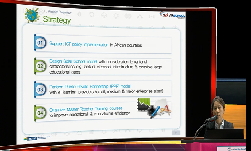Learning science requires students to make inferences and difficult to imagine. Scientific visualization is one way to make science and scientific thinking more visible to students. This dissertation investigates how visualization can be utilized for...
http://chineseinput.net/에서 pinyin(병음)방식으로 중국어를 변환할 수 있습니다.
변환된 중국어를 복사하여 사용하시면 됩니다.
- 中文 을 입력하시려면 zhongwen을 입력하시고 space를누르시면됩니다.
- 北京 을 입력하시려면 beijing을 입력하시고 space를 누르시면 됩니다.
https://www.riss.kr/link?id=T10541125
- 저자
-
발행사항
[S.l.]: University of California, Berkeley 1999
-
학위수여대학
University of California, Berkeley
-
수여연도
1999
-
작성언어
영어
- 주제어
-
학위
Ph.D.
-
페이지수
302 p.
-
지도교수/심사위원
Chair: Marcia C. Linn.
-
0
상세조회 -
0
다운로드
소속기관이 구독 중이 아닌 경우 오후 4시부터 익일 오전 9시까지 원문보기가 가능합니다.
부가정보
다국어 초록 (Multilingual Abstract)
Learning science requires students to make inferences and difficult to imagine. Scientific visualization is one way to make science and scientific thinking more visible to students. This dissertation investigates how visualization can be utilized for science education by studying how students integrate information from visualizations into their thinking.
For this study, I developed a series of computer visualizations depicting thermodynamic phenomena. Thermodynamics is a topic that is both fundamental for several branches of science and difficult for many students to master (Linn & Songer, 1991). The design of the visualizations was learner centered. Pilot studies suggested that a dot-density representation of temperature would present a visual analogy of temperature as a measure of heat energy density. Energy density is a powerful model that can help students explain everyday heating and cooling phenomena.
Dot-density computer visualizations were introduced into a public middle school science class studying thermodynamics (N = 178). Half of the students used the visualizations, while the other half served as a control. Interviews, classwork and tests were collected from the students in order to determine how the visualizations affected students' learning. Although there were not significant differences in the posttests for the groups, the classwork during the semester showed that the visualizations did affect how students envisioned heat and temperature. Students could often apply the energy density model in their reasoning during visualization activities, but when the visualizations were unavailable, many students applied less useful models.
The interviews illustrated several difficulties that students had in learning from the visualizations. Some students interpreted the visualizations to support their existing conceptions of heat. Other students needed to have a visualization present to cue the energy-density model during problem solving. On the posttest, some students drew images with dots in them, but they lacked the model that underlies the representation. Students who avoided these problems and integrated the visualizations into their thinking were highly successful on the posttest.
These results suggest that for visualizations to be effective learning tools, students need to understand the visualizations and also explore underlying scientific model. Students in this study who connected the visualizations to other ideas about thermodynamics developed a robust understanding of the science. These findings inform our understanding of the science learning process. Students appear to draw from a repertoire of models in their reasoning. Visualizations are a powerful way to introduce models to students, but work best with opportunities for students to integrate the models into their thinking.
분석정보
연관 공개강의(KOCW)
-

Developments in 14-19: Institute of Education
Teachers TV Teachers TV -

Education Policy at the Party Conferences
Teachers TV Teachers TV -

2014 이러닝 국제 콘퍼런스 : What is the Lessons from Education Support Project~
한국교육정보진흥협회 Boseon, Kim -

Personal Finance Education: The Money Quiz
Teachers TV Teachers TV -

Further Education: Work Experience
Teachers TV Teachers TV







